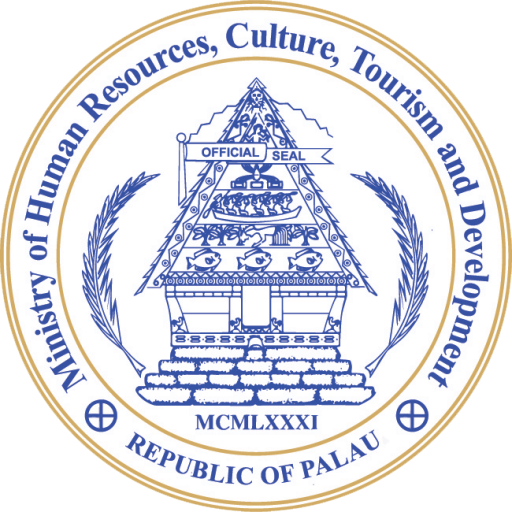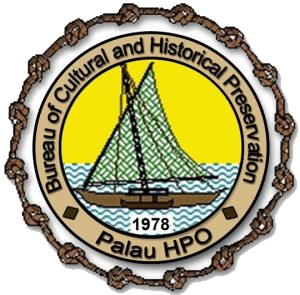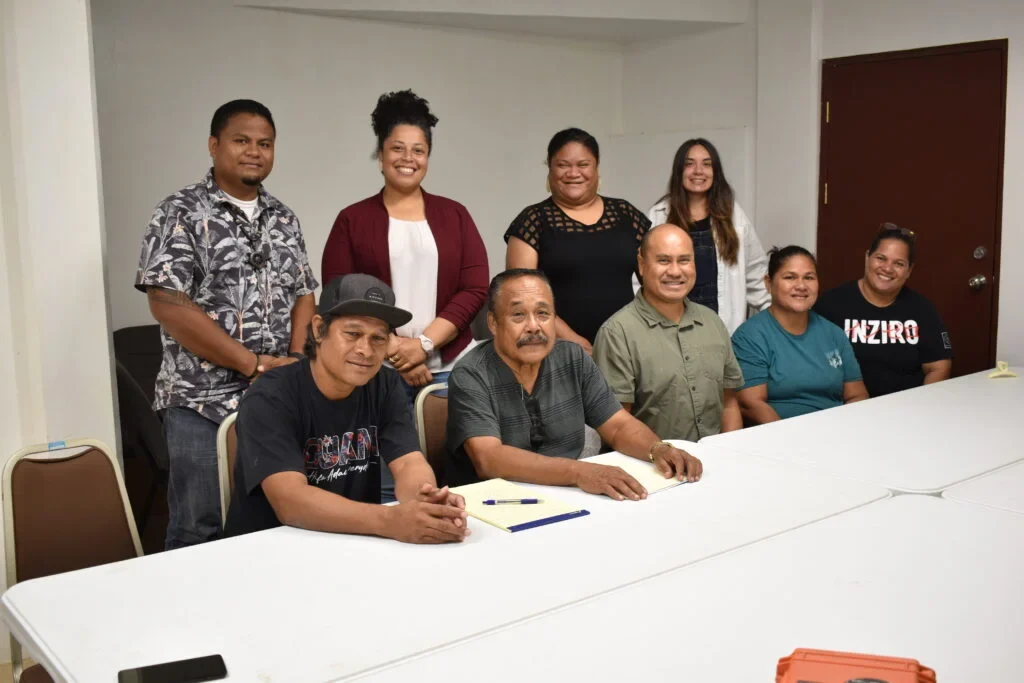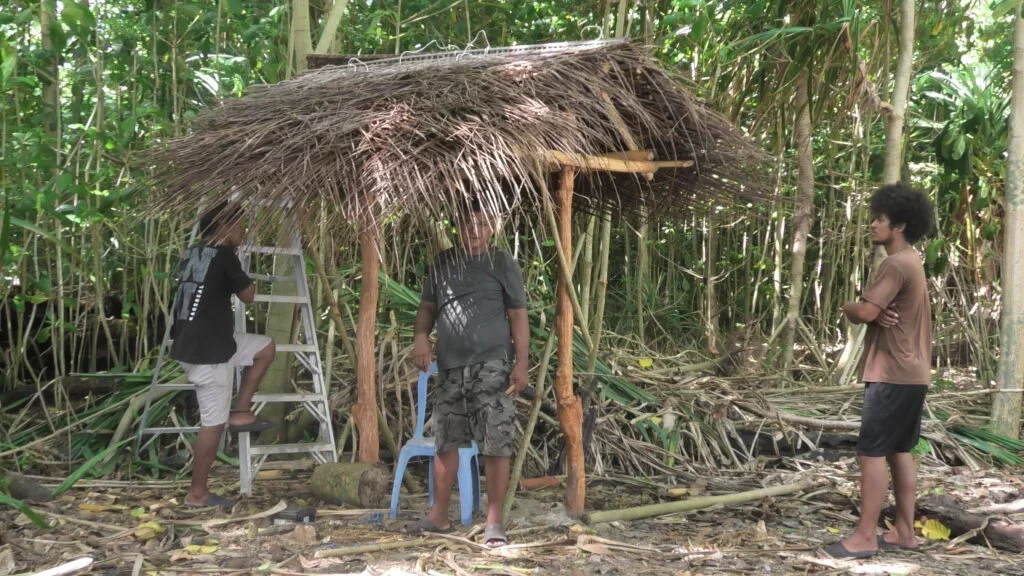Photo by McMichael Mutok Jr. (March 2023)
Japanese Defense Fortification
WWII Historic Remains in Sonsorol State
- Sonsorol
Site Type
Date Registered
Site No
History
In recognition of its significance, Japanese Defense Fortification site number B:SU-3:1 Feature 1 along with Feature 32 and Feature 33 has been listed in the Palau Register of Historic Places on March 30, 2020. Through preservation, study, and interpretation, the site can serve to educate future generations concerning the historical and cultural heritage of the Palauan people and Sonsorol State.
This World War II Historic Remain known as feature 1 has a dimension of 3.70 meters x 255 meters. It is a Japanese open position located north of the residential area and right along the shoreline. The feature has a U-shape wall made of coral rocks re-enforced with concrete. It has an elevation of approximately one meter with two firing slits facing the water. It is still in good condition and surrounded with small trees and shrubs.
This World War II Historic Remain known as feature 32 is a Japanese open position located at the southwest corner of the island and on the west side of the path that goes around the island. The structure is made of coral rock wall reinforced with concrete with approximate height of 1 meter. It has a U-shape with two firing ports facing the water with an entrance at the back to the east. Located at a few meters to the east are two rock alignments reinforced with concrete. The feature is still in good condition.
Feature 33 contains two Japanese pillboxes that were once connected by a trench. These are located several meters southeast of feature 32 at the southwest corner of the island and on the west side of the path.
The trench has been filled with sand and is now a shallow depression. The first pillbox is located beside the path with concrete roof with rusty rails reinforcing it. The interior has been dug into a rubble berm with narrow opening to the east and a firing port facing the water. The second pillbox is located to the west and made of coral rocks reinforced with concrete with an approximate height of little over one meter. It has a U-Shape with wings and an entrance facing the water to the west. The roof is made of concrete and coral rocks on top of rusty rails. The whole structure is still in excellent condition and the interior is free of debris.
These Japanese Defense Fortifications are significant with unique methods and materials used in its construction. Prior to the invasion of the islands of Palau especially Peleliu by U.S forces in 1944, the Japanese military began an intensive program of fortification construction on the island of Sonsorol. This program was severely disadvantaged by the lack of construction materials especially cement and reinforcing steel. As a result, Japanese construction engineer found it necessary to substitute materials and modify design plans. Coral rocks were used in place of poured concrete and railroad tracks were used in place of manufactured reinforcing rods. The use of these substitute materials, together with clever placement utilizing natural features, resulted in a functional defense position which was nearly invisible to aerial and ship reconnaissance.
The Onset of World War II
As the war began, three ships full of Japanese soldiers came to Sonsorol. An old man, a retired Japanese soldier who was with the Nantak Company, had informed the islanders earlier that they should not look or stare at the face of the commanding officer of the Japanese soldiers. He told them that if they do, they would be severely punished; and might even have their head cut off. This scared the islanders.
The islanders stood on both side of the road leading to the dock with their heads bowed down as the commanding officer walked by. A Japanese flag was raised on the island of Sonsorol. The soldiers brought their supplies and tents with them. The Japanese community in Sonsorol and several of the islanders were busy attending to the soldiers and their needs. Few of the islanders who had sambas, type of boat, volunteered their boat for carrying the heavy things from the ship to the island. Once on the island, the Japanese soldiers began to dig trenches and small tunnels. The soldiers stayed in the jungle but most of their supplies were stored in the traditional social hut, faremau. As the war progressed the Sonsorolese relocated to Fana, a nearby island. The people stayed in Fana until word came that the war was over. They learn of this news through the pamphlets that were air dropped by the American planes.
Most of the islanders in Fana still did not believe that the war was over until Kintaro who remained in Sonsorol came to Fana with the confirmation that the war was really over. When Kintaro was in Sonsorol, he asked the Butaichio, second leader of the Japanese soldiers, if the war was over. Butaichio confirmed that the war is over. He gave his sword to Kintaro to take it. When Kintaro came to Fana with the news that the war is over, he picked a dried Pandamus tree and set it on fire to show his happiness. He did this because during the war, making fire was prohibited by the Japanese soldiers because it would draw the attention of the enemies to them. The only allowed light was of the lanterns at night.
Left: Feature 1 and Feature 32 Open Position with U-Shape Wall / Photo by McMichael Mutok Jr. (March 2023)
Right: Map of Sonsorol with Associated Features (Olsudong et al 32 & 33)
CHELDECHEDECHAL
Tia el olsechall el Japanese Defense Fortification el Site Number B:SU-3:1 Feature 1 me a dirrek el Feature 32 me a Feature 33 a siliseb er a omsengelel a klalo er a Ibetel a Cherechar (Palau Register of Historic Places) er se er a March 30, 2020. Tia el olsechall a ta er a mekreos el ibetel a cherechar er a Belau, el kmal klou a ultutelel el olsechall el mo er a rechad me a beluu er a Sonsorol.
Tia el olsechall a ngar er ngii a kot el ochotall (Feature 1), ng euatel me a lechub e ng blil a boes el bekord el euid el dart el sak a klungel el meliuekl (Dimension) el di teleu a bebul a nga er a diluches er a basio el blil a delengchokl el meleliuekl er a kederang. Tia el blil a boes a deuerrakl a teletelel e selment el obengkel a bad el chei. Ng bekord el eua el sak a telongeklel e ngar er ngii a eru el belsibelel el blil a medal a boes el di mo bedul a daob. Tia el ochotall a dirk el ungil e betok a mekekerei el dellomel me a kerrekar el meliuekl er ngii.
Tia el olsechall a ngar er ngii a Okedei me a Eru el Ochotall (Feature 32) ng blil a boes er a rechisiabal el ngar er a dims ngebard er tia el iungs e mo bedul a ngebard el rael el meliuekl er a beluu. Tia el blil a boes a selment el obengkel a bad el chei e bekord el edei el sak a kemengetel e rrul el kora deuerrakl a teletelel e nga er ngii a eru el dechor el blil a boes el chemau a daob e ngar er ngii a siseball el ngar er a rebai el mo bedul a ongos. Ngar er ngii a erul el chelderodel el bad el obengkel a sment el klisichel tia el blil a boes el diak el sal cheroid el mo bedul a ongos. Tia el blil a boes a dirk ungil el telketokel.
A Okedei me a Edei el Ochotall (Feature 33) a eru el blil a boes er a rechisiabal el daibechebech el ngar er ngii a kora ledes e ng telkib el dmolech el omech aika el teblong. Aika el eru el blil a boes a diak el sal cheroid er a okedei me a eru el ochotall el nga er a dims ngebard er tia el iungs e mo bedul a ngebard er a rael. Tia el ledes a bla lokekii er a chelechol meng mla mo kora kesmeched. Se el kot el blil a boes a di ngar er a bita er a rael el sment a chedeuel me a mla mo mechut el deel el melekau er ngii. A chelsel tia el blil a boes a mla mekiis me ng betok a ulengkongk er ngii el di kekerei el medechel el metetoech el blil a medal a boes. Tia el chelsel a dirrek el ulekeek er a bad el chei me a betok el besbas. Sel el ongeru el blil a boes a mo bedul a ngebard e rrul er a bad el chei me a sment el bekord el edei el sak a telongeklel. Ng kora deuerrakl a teletelel e ousebek el tungelel a chemau a daob el mo bedul a ngebard. Ng rrull er a sment me a bad el chei e cheldool er a mla mo mechut el deel el orkedall. Tia el rokir el klalo a kmal dirk ungil me a chelsel meng mededaes el diak a kikiongel er ngii.
Aika el blil a meklou el boes malechub e ng euatel er a ongeru el mekemad er a beluulechad a ileakl e ngodech el teletael er a klekedall a luluusbech el meleketek a euatel er a beluu er a Sungesol. Tia lureor a mle chetituokel le ng dimlak a klekedall er a omeleketek el blai el ua sment me a deel. Ng mlo uchul e te uluusbech a bad el chei me a deel el mle rolel a mekekerei el kora ksia el mo melsiich aika el bad el chei el bla le cherad me ng kora sment. Tiaikid el kldachelbai a mlo uchul e aika el euatel a mle meringel el meues er a rechad er a merikel.
CHELDECHEDUCH ER A UCHELEL A ONGERU EL MEKEMAD ER A BELUULECHAD
Me a lomuchel a mekemad e a kldei el diall el mui er a rsoldau er a siabal el mle er a sungesol. Ngar er ngii a chuodel el rubak el mle soldau er a siabal el mle bliongel el mo er a cheldebechel er a Nantak a uluuchais er a rechad er a Sungesol el kmo ngdiak el kirir el omes me a lechub e tolengeng a medal ngke el merreder er a resoldau er a Siabal le ng sebechir el mo meringel el mekelbus me a lechub e ng metuk a bderrir. Tia el tekoi a kmal blo le medakt er ngii a rechad er a Sungesol. A rechad er a Sungesol a dilechor er a tkul a rael er a bita me a bitang e chelid a chiklir e tellatel el di omes er a chutem er se er a be lengakl a mengeteklel a soldau e le ngerdii a banderang er a Siabal. A rechad er a Siabal el kiliei er a Sungesol me a rechad er a Sungesol a mle mechesang er a omngedmeklir a rsoldau lolngakt a klalo el mo er a diall. A rebebil er a rechad er a Sungesol el mla rengii a bos er tir a dirrek el lullengeseu er a ongektel a klalo er a diall el me er a beluu. Me se er a leme er a beluu a resoldau er a Siabal e tulemuchel el mengiis a kliokl me a mekekerei el ii. A resoldau a kiliei er a chereomel eng di oumesind er a klekedellir a mla er a delidui el blai er a Sungesol el lomekedong el kmo; Faremau. Ma le kora merengla mekemad e a rechad er a Sungesol a mlengukl el mo er a Fana el iungs el di kmeed. Te kiliei er a Fana e ngii merma tekoi el kmo ng merko mekemad lokiu a babier el lulerrebt a rechad er a Merikel er a skoki.
A ruumesind el chad el mla er a Fana a dimlak lomerang el kmo ng merko mekemad. Ng bai Kintaro el di kilie er a Sungesol a merma er a Fana louchais el kmo ng meral merko mekemad. Se er a lengara Sungesol a Kintaro e ngulleker er a ongeru el soldau er a resoldau er a Siabal er a chisel a mekemad me ng nguluuchais el kmo ng mla mo merek a mekemad. Me a Kintaro er sera lemei er a Fana e ng ngulba kmard el llel a lius el lolchotel a deureng. Ng mirrull el uaisei le rechisiabal a ulemul a ngau le ng ngolchau er a recheraro. Ng di tal kmard el olbidel el kora lambei a mle subed er a klebesei.
Compiled by McMichael Mutok Jr.
Palau National Register of Historic Places
Bureau of Cultural and Historical Preservation
Sign up to receive the BCHP monthly newsletter.
FY’21 Site Rehabilitation and Conservation Project
The site rehabilitation and conservation project of Japanese Defense Fortification located in Sonsorol State commence on April 01, 2023 and completed on September 30, 2023. The project involved clearing overgrowth trees, vines, algae, etc. from historic remnants to prevent it from cracking, corroding or deterioration. Other modifications such as digging of trenches and moving of historic remnants will be supervised by village elders and monitored by the Bureau. Including a construction of a 2ft x 3ft interpretive sign using traditional materials at the site.
The main purpose of this project is to educate and motivate the public, especially the affected villagers to realize the importance of the site and its potential economic benefits. Through the project, the concerned executives, traditional leaders and individuals could be reminded once again that these precious resources are theirs and should be maintained for many reasons: for present and future generations to learn and enjoy; for continuous education; for heritage tourism; and for economic development.
Governor Nicholas Aquino and the community of Sonsorol State feel fortunate to have one of their precious sites rehabilitated and have access for visitors. They believe that this is one way for others to learn about their state’s history and thanked the Bureau of Cultural and Historical Preservation under the Ministry of Human Resources, Culture, Tourism and Development for their on-going efforts in helping small communities little by little with their financial assistance.
Source
Dr. Carmen C.H Petrosian – Husa. Melson Miko. and Moline Smaserui. 2003. Vol. II. Collection of Oral History. Pp. 37 -40.
Olsudong, Rita. Richard Knecht. Calvin T. Emesiochel. Errolflynn T. Kloulechad. 2004. Archaeological Inventory and Oral Histories: Survey of Sonsorol State: Bureau of Arts and Culture (Historic Preservation Office). Ministry of Community and Cultural Affairs. Pp. 33-34 & 48.
Olsudong, Rita. Calvin T. Emesiochel, Errolflynn T. Kloulechad. 2003. Inventory of Cultural and Historical Sites and Collection of Oral History in Hatohobei and Sonsorol States. Vol. I. Inventory of Cultural and Historical Sites. Pp. 74-76
CODE OF CONDUCT
Given the importance of this site to Palauans in terms of their history and culture and the concerns that exist in regard to its future, those visiting the site should not engage in any type of behavior or activity that disturbs the integrity of this site or diminishes the respect that should be accorded to it.
PALAU HISTORIC PRESERVATION GUIDELINES
Because of the importance and sensitivity surrounding this and all historical registered sites, the Palau Historic Preservation Office would like to emphasize proper conduct for visiting a site through the following guidelines.
1) Remember that many sites include culturally sensitive areas and therefore behavior should be always be respectful.
2) Remember to take everything you bring to the site with you when you leave.
3) Do not remove anything from the site. Although you may not think something is significant to the site, all pieces make up the whole.
Location of Beluu er a Japanese Defense Fortification, Sonsorol
Compiled by McMichael Mutok Jr.
Palau National Register of Historic Places
Bureau of Cultural and Historical Preservation




